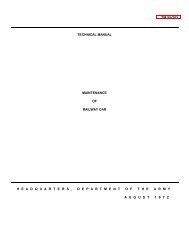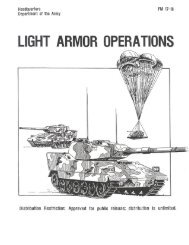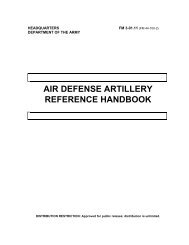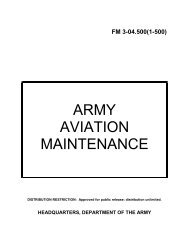fm 44-100 us army air and missile defense operations
fm 44-100 us army air and missile defense operations
fm 44-100 us army air and missile defense operations
You also want an ePaper? Increase the reach of your titles
YUMPU automatically turns print PDFs into web optimized ePapers that Google loves.
FM <strong>44</strong>-<strong>100</strong><br />
6-8<br />
AMDCOORD bases the recommendation on a careful target value analysis<br />
<strong>and</strong> estimate of the <strong>air</strong> threat.<br />
FIRE SUPPORT<br />
6-29. Fire support enhances tactical-level <strong>air</strong> <strong>and</strong> <strong>missile</strong> <strong>defense</strong>. Indirect<br />
fire weapons can deny enemy helicopters the <strong>us</strong>e of masked, st<strong>and</strong>off positions.<br />
Fire support systems can concentrate their fires on enemy l<strong>and</strong>ing<br />
zones, pickup zones, launch sites, comm<strong>and</strong> <strong>and</strong> control, assembly areas, <strong>and</strong><br />
FARP. Surface-to-surface fire coordination for OCA <strong>operations</strong> takes place<br />
through the targeting process. Fire support elements coordinate targets for<br />
attack by joint <strong>air</strong> forces supporting corps <strong>and</strong> division <strong>operations</strong>.<br />
6-30. The AMDCOORD works closely with the FSCOORD, G3, <strong>and</strong> G2 during<br />
the targeting process to prioritize OCA <strong>and</strong> TMD targets. The enemy's ability<br />
to disrupt friendly <strong>operations</strong> dictates target priority. The AMDCOORD<br />
makes target recommendations, weighing them against other requirements<br />
of the comm<strong>and</strong>er's plan competing for the same fire support. Many OCA <strong>and</strong><br />
TMD targets fall into the category of deep targets. Therefore, long-range fire<br />
support assets are the optimal means to attack them.<br />
AVIATION<br />
6-31. Army aviation contributes to <strong>air</strong> <strong>defense</strong> <strong>and</strong> joint counter<strong>air</strong> activities<br />
through <strong>air</strong> combat <strong>operations</strong>. Air combat provides aviation self-<strong>defense</strong>,<br />
combined arms maneuver forces protection, <strong>and</strong> <strong>air</strong> <strong>defense</strong> forces augmentation.<br />
Air combat <strong>operations</strong> support the force comm<strong>and</strong>er's overall concept of<br />
<strong>operations</strong>. The maneuver comm<strong>and</strong>er's decision to <strong>us</strong>e aviation in other than<br />
a self-protection, <strong>air</strong> combat role m<strong>us</strong>t be weighed against its primary antiarmor<br />
mission. Air combat <strong>operations</strong> are planned to support the ground tactical<br />
plan <strong>and</strong> can be either offensive or defensive.<br />
6-32. Aviation can conduct attacks against OCA <strong>and</strong> TMD targets that cannot<br />
be effectively engaged by indirect fire systems. Army aviation also participates<br />
in <strong>air</strong> assault <strong>operations</strong> against OCA <strong>and</strong> TMD targets. The force<br />
comm<strong>and</strong>er plans <strong>air</strong> security <strong>and</strong> SEAD missions to support Army aviation<br />
deep strike OCA <strong>and</strong> TMD <strong>operations</strong>.<br />
6-33. Army aviation participates in DCA <strong>operations</strong> primarily by attacking<br />
aerial targets of opportunity <strong>and</strong> by engaging enemy <strong>air</strong> targets in self<strong>defense</strong>.<br />
However, the force comm<strong>and</strong>er may give Army aviation forces the<br />
mission to screen the force against RSTA UAVs. Other DCA <strong>operations</strong> conducted<br />
by Army aviation occur in response to specific <strong>air</strong> threats. Army aviation<br />
DCA goals are to provide self-<strong>defense</strong> <strong>and</strong> augment the <strong>air</strong> <strong>defense</strong> capability<br />
of the combined arms team on the ground. Air cavalry squadrons <strong>and</strong><br />
attack helicopter battalions can fill gaps in the force's <strong>air</strong> <strong>defense</strong> when ADA<br />
units are redistributing assets <strong>and</strong> adj<strong>us</strong>ting forces. Helicopters in an <strong>air</strong><br />
combat role also can provide <strong>air</strong> <strong>defense</strong> during screening missions. Early<br />
warning provided by screening or attack aviation assets m<strong>us</strong>t be integrated<br />
into ADA early warning <strong>and</strong> vice versa.<br />
6-34. Coordination between the aviation <strong>and</strong> ADA comm<strong>and</strong>ers is particularly<br />
important, as aviation forces m<strong>us</strong>t operate in the <strong>air</strong>space within the<br />
ADA engagement coverage. Prevention of fratricide is a major element of











